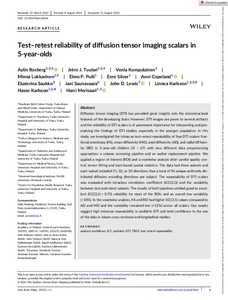Hae
Aineistot 1-10 / 11
Feasibility of FreeSurfer Processing for T1-Weighted Brain Images of 5-Year-Olds: Semiautomated Protocol of FinnBrain Neuroimaging Lab
<p>Pediatric neuroimaging is a quickly developing field that still faces important methodological challenges. Pediatric images usually have more motion artifact than adult images. The artifact can cause visible errors in ...
Subcortical and hippocampal brain segmentation in 5-year-old children: Validation of FSL-FIRST and FreeSurfer against manual segmentation
<p>Developing accurate subcortical volumetric quantification tools is crucial for neurodevelopmental studies, as they could reduce the need for challenging and time-consuming manual segmentation. In this study, the accuracy ...
Effect of number of diffusion-encoding directions in diffusion metrics of 5-year-olds using tract-based spatial statistical analysis
Methodological aspects and effects of different imaging parameters on DTI (diffusion tensor imaging) results and their reproducibility have been recently studied comprehensively in adult populations. Although MR imaging ...
Infant and Child MRI: A Review of Scanning Procedures
Magnetic resonance imaging (MRI) is a safe method to examine human brain. However, a typical MR scan is very sensitive to motion, and it requires the subject to lie still during the acquisition, which is a major challenge ...
Maternal pre-pregnancy BMI associates with neonate local and distal functional connectivity of the left superior frontal gyrus
Maternal obesity/overweight during pregnancy has reached epidemic proportions and has been linked with adverse outcomes for the offspring, including cognitive impairment and increased risk for neuropsychiatric disorders. ...
Neonatal Amygdala Volumes and the Development of Self-Regulation from Early Infancy to Toddlerhood
<p><i>Objective:</i> At the broadest level, self-regulation refers to a
range of separate, but inter-related, processes (e.g., working memory,
inhibition, emotion regulation) central for the regulation of cognition,
emotion ...
Prenatal and early-life environmental factors, family demographics and cortical brain anatomy in 5-year-olds: an MRI study from FinnBrain Birth Cohort
The human brain develops dynamically during early childhood, when the child is sensitive to both genetic programming and extrinsic exposures. Recent studies have found links between prenatal and early life environmental ...
Test-retest reliability of diffusion tensor imaging scalars in 5-year-olds
Diffusion tensor imaging (DTI) has provided great insights into the microstructural features of the developing brain. However, DTI images are prone to several artifacts and the reliability of DTI scalars is of paramount ...
A variation in the infant oxytocin receptor gene modulates infant hippocampal volumes in association with sex and prenatal maternal anxiety
Genetic variants in the oxytocin receptor (OTR) have been linked to distinct social phenotypes, psychiatric disorders and brain volume alterations in adults. However, to date, it is unknown how OTR genotype shapes prenatal ...
Sex-specific associations between maternal pregnancy-specific anxiety and newborn amygdalar volumes-preliminary findings from the FinnBrain Birth Cohort Study
Previous literature links maternal pregnancy-specific anxiety (PSA) with later difficulties in child emotional and social cognition as well as memory, functions closely related to the amygdala and the hippocampus. Some ...









